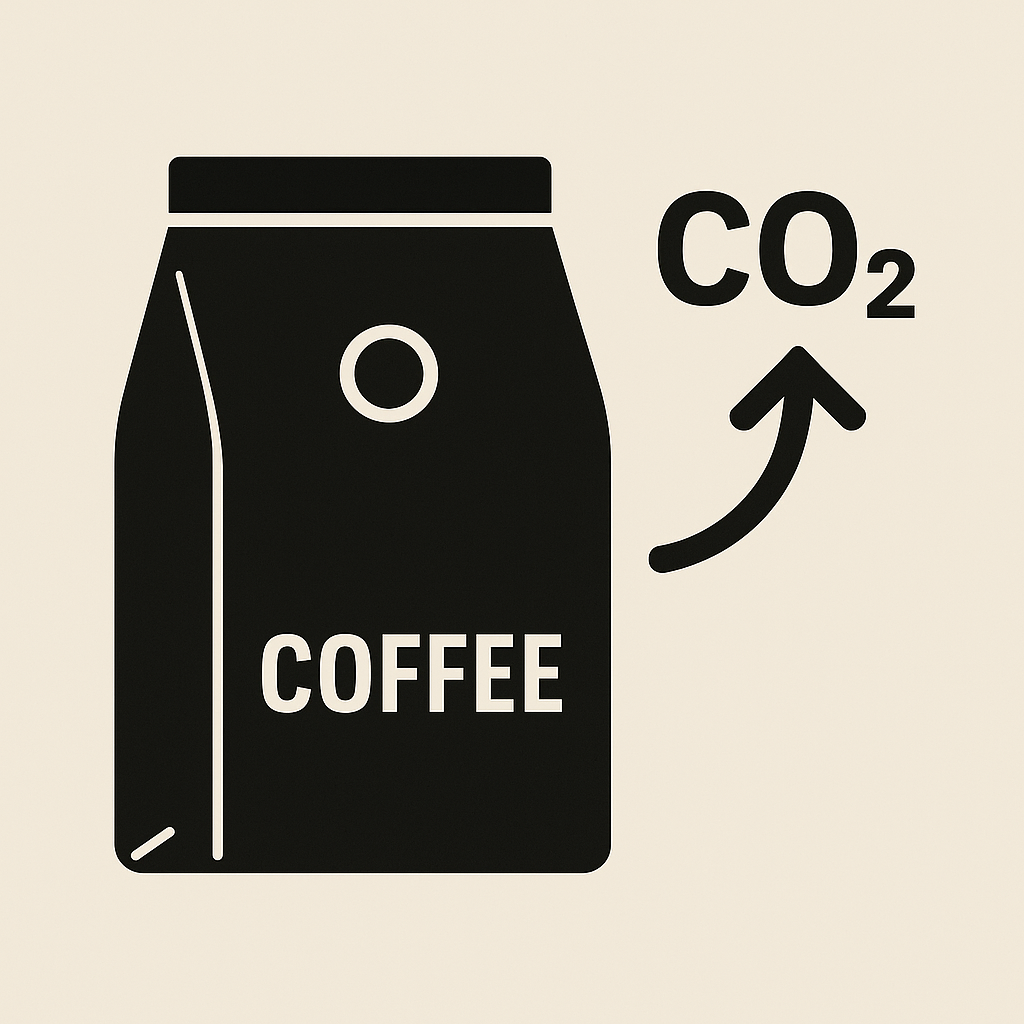Freshly roasted coffee continues to release carbon dioxide (CO2) for days, sometimes even weeks, after roasting. This natural release of gas is beneficial to the health of the beans, but it can have adverse effects within the supply chain: trapped CO2 can cause coffee bags to swell and break the seal, while oxygen that sneaks back in can accelerate coffee staling. This is why the humble one-way degassing valve remains one of the most important components of modern coffee packaging.
What the Exhaust Valve Does (and Why It’s Not Optional)
A one-way degassing valve allows internal gases to escape while preventing outside air from entering the bag. For roasters, this has a dual effect: it protects the integrity of the bag during shipping and storage while preserving the aroma and flavor components that define the coffee’s character. Without the right degassing valve, even perfectly roasted beans can arrive bland or oxidized, ruining months of sourcing and roasting work.
Valve types and practical choices for baking machines
Not all valves are created equal. Standard valves are made from food-grade polymers (typically PP or PE) and rely on a simple diaphragm that opens under internal pressure and closes when pressure equalizes. Tonchant offers a variety of options to meet your brand’s needs:
• Low-profile one-way valve for retail stand-up pouches – minimal visual impact, reliable exhaust flow.
• Medium flow valves are suitable for freshly roasted high CO2 coffees that require rapid degassing within the first 24-72 hours.
• Heavy duty valves for export or large 1 kg bags where long degassing times are required or where transport conditions are harsh.
The valve selection depends on the roast level, bean type, package size, and expected delivery time. Tonchant’s technical team will help customers select the appropriate valve flow rating to ensure the bag does not bulge or accumulate gas.
Installing the Valve into the Bag: Placement and Procedure
Valve placement is critical. Installing the valve centrally on the front of the bag, typically above the centerline and below the bag’s zipper or top seal, offers the best balance between functionality and aesthetics. Tonchant automates valve insertion to micron-level tolerances: the machine precisely punches the hole, positions the valve, and secures it with a heat-sealed patch or ultrasonic welding. This automated technology ensures an even bond and eliminates weak spots that could become leak paths.
Tonchant’s valve bag production process includes: substrate printing → lamination → bag forming → valve installation → final sealing and quality control. For bags with valve zippers, the zipper is installed before the valve to prevent interference with the sealing operation. Each step is monitored through in-line inspection to ensure repeatable performance.
Quality Control and Testing You Can Trust
Valves only function properly if they are installed and tested correctly. Tonchant subjects each production batch to a battery of tests: leak detection, burst testing (simulating shipping pressure), and flow verification to ensure the valve opens at the correct pressure. Samples also undergo accelerated shelf-life simulations to ensure the valve’s barrier properties haven’t been compromised over time.
Sustainability Trade-Offs—and Tonchant’s Approach
Here’s the tough truth: Traditional plastic valves complicate compostability and some recycling processes. Tonchant takes a pragmatic approach: When customers request industrial compostability, we offer PLA-lined kraft paper bags and collaborate on low-impact valve strategies, such as using recyclable, mono-material valve patches or suggesting valve positions for easier material separation during recycling.
For customers prioritizing full recyclability, Tonchant offers compatible single-material bag construction and recyclable valve solutions, or recommends short-cycle logistics and valve-free barrier alternatives where valve use would hinder end-of-life goals.
Added features that improve performance and convenience
Beyond simple venting, Tonchant’s valved bags can be equipped with resealable zippers, tear notches, matte or soft-touch finishes, and custom printed branding. We also combine the one-way valve with other functional elements—such as tin strapping options for 1kg bulk sizes or gusseted bottoms for shelf display—to create packaging that meets the needs of the retail, wholesale, and foodservice industries.
Why Bakers Choose Tonchant for Valve Packaging
Tonchant combines material expertise, in-house printing, and automated valve installation technology to deliver consistent pouch performance at competitive production volumes. Our Shanghai facility adheres to stringent quality regulations, supports low minimum order quantities through digital printing, and offers clients a clear path to scale-up flexographic printing. For each project, we provide sample verification and taste testing, allowing roasters to verify aroma retention and pouch durability before committing to large-scale production.
Practical tips for coffee brands considering valve bags
• Timing the refill: For many roasters, refilling 24-72 hours after roasting reduces pressure spikes and minimizes valve pressure.
• Mark the baking date. Paired with a valve, the clearly visible baking date gives consumers confidence in freshness.
• Request valve flow data. If you ship internationally, request flow ratings so your logistics partner can predict bag behavior during shipping.
• Consider end-of-life disposal options. Determine whether compostability, recyclability, or valved recyclability is a priority and select materials accordingly.
Get started with Tonchant testing valve solutions
A one-way degassing valve may be a small part, but it has a significant impact on coffee quality and logistics. Tonchant provides roasters with valve selection, prototyping, and comprehensive production support to balance freshness, functionality, and sustainability. Contact Tonchant to request a sample bag with a valve, discuss material strategies, or schedule a technical consultation. Your roasted coffee beans need packaging that protects their flavor—and that protection starts with the right valve.
Post time: Aug-23-2025
